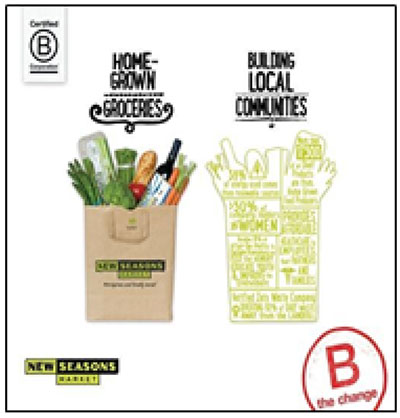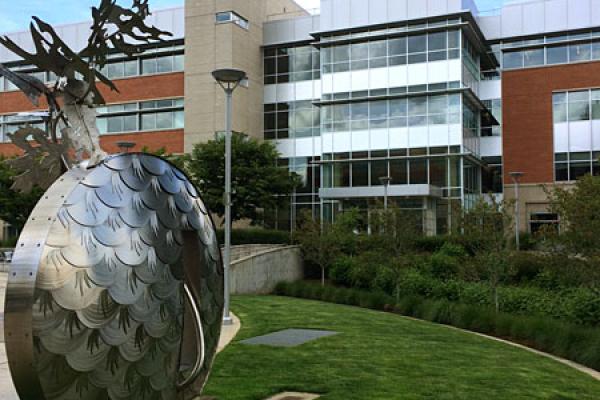1. A green team or individual has management’s support to implement sustainability efforts.
Just one sustainability champion can make all the difference, but the larger your organization, the more important it is to consider establishing a sustainability group that includes representatives from throughout the organization. This can spread out the work and decision-making responsibilities while giving you a broader base of people who can identify opportunities for improvement. The City of Portland’s Green Team Guide is a great guide to learn how to start a green team and to keep everyone engaged.
Train your green champions. Consider sending champions to attend a Master Recycler or Recycling 101 course to provide members of staff with the skills to improve the resource efficiency of your organization. Your business can also join the Association of Oregon Recyclers (AOR), a trade organization that has advanced recycling and waste prevention in Oregon since 1977.
2. New employees are trained on sustainability best practices — including on waste reduction, recycling and commuting options — and all employees are educated at least once a year.
Educating employees on the value of recycling and how to manage materials is a great way to let staff know the importance of the program. A Sustainability Advisor can connect you with resources to help educate staff, such as this e-training tool , which you can forward to staff and/or ask new employees to complete. Be sure to provide new hires with details and directions on your recycling set-up, alternative commuting options, best practices for computer use and printing, etc. It’s helpful to take new employees on a short tour of where certain materials are collected for recycling, where to find bike storage and locker rooms, etc. If you have a written orientation packet, include such information there as well. If, however, you don’t have enough employees to justify orientation materials, consider creating a one-pager with a list of recycling FAQs and sustainability best practices. Examples are available from a Sustainability Advisor.
New employees aren’t the only ones who should hear about your organization’s sustainability practices, however. All of us benefit from a refresher now and then. Make it a practice to review sustainability best practices at least annually, and consider featuring recycling or sustainability training at a staff meeting. Create a space in the break room, or use employee intranet pages and/or a section of your employee newsletter to post articles and information about sustainability-related facts or events. Contact us if you are interested in a short training presentation by our staff.
3. An employee at the management level owns overall responsibility for sustainability efforts.
Management plays a vital role in overall company-wide sustainability. Having management support makes implementing sustainability plans much easier, but if getting upper management buy-in is a challenge, we have tools to help show the business case for sustainability. For instance, many businesses find that sustainability is a key factor in attracting and retaining business talent.
4. Assess and prioritize actions that support the triple bottom line, and track the financial impacts of sustainability activities.
An important consideration in building employee awareness about sustainability is to understand the level of impact that such issues can have on the company and stakeholders. A sustainability program often starts with issues or projects that are of the initial greatest interest to the business and its stakeholders and that offer a good return on investment. However, you can track any aspect related to the triple bottom line, whether it’s about people, planet or profit. Some impacts of taking sustainability actions are easier to track than others. However, any time you can demonstrate the result of sustainability actions, whether it’s helping your business save money through reduced car trips or assisting members of your community in volunteer time, you are further embedding sustainability into how business is run.
5. A social responsibility mission statement has been established and is shared with both employees and the public.
A social responsibility mission statement is one that explicitly ties your company mission to its impacts on people and community. To publicize your commitment to social sustainability, we recommend you revise your mission, vision or value statements to include principles of sustainability, or write a separate statement. For some inspiration, check out some of these examples or email your Sustainability Advisor for some additional examples.
Getting Started:
- Encourage participation and input from all employees. A shared vision helps each employee understand how he or she individually contributes to the company’s success, as well as how everyone contributes collectively. To increase stakeholder engagement, gather a team that represents different levels and departments within your organization, which will help you create a message that resonates with everyone.
- Determine what social sustainability means to your organization. Sustainability is a value-based term. Drill down to the core of the triple bottom line and consider how it relates to your business. You can use the beginning of this guide as a resource.
- Write and post a draft of the statement. After all employees have had a chance to review and discuss it, use this information to refine your organization’s mission statement.
6. A sustainability report reflecting goals and progress is produced and reviewed annually.
A sustainability report is a periodic report that discloses an organization’s approach to, and performance in, sustainability issues. It is a vital component of employee, shareholder and stakeholder relations.
Sustainability reporting requires organizations to gather information about processes and impacts that they may not have measured before. A sustainability report quantifies, measures and tracks environmental and social performance in the same form with which it tracks financial performance: metrics analyzed over time. This new data can provide knowledge necessary to reduce the use of natural resources, increase efficiency and improve operational performance, in addition to creating greater transparency about an organization’s overall performance.
Sustainability is a competitive advantage as well, and it is only becoming more so. Companies seen as leaders and innovators are in a stronger position for attracting customers and investment, initiating new activities, entering new markets and negotiating contracts.
7. Maintain a centralized location or other system for employees to find information on sustainability-related resources.
Create a space in the break room, or use employee intranet pages and a company newsletter to post articles and information about sustainability facts or events. This is a great way to engage employees who want to contribute to your sustainability mission, and to share community resources around sustainability. You can post alternative transportation information, neighborhood hazardous waste collection events, your most current sustainability report if you have one or opportunities to volunteer or give back to local sustainability-related nonprofits.
8. A system is in place to gather employee feedback and suggestions related to sustainability practices and policies.
The best ideas for new sustainability practices oftentimes come from employees who notice opportunities for improvement while going about their typical workday. Employees can identify wasteful practices and opportunities for improving efficiencies, for example, while bringing in outside ideas that enhance your sustainability goals. Asking for feedback encourages employees to take ownership over sustainability practices and demonstrates that everyone is in it together.
9. There are policies in place for sustainable procurement, such as through a green purchasing policy and/or inclusion of sustainability considerations in bids for procurement.
Policies make expected behaviors explicit and promote a set of values related to sustainability. Research has demonstrated that sustainable procurement can yield positive economic benefits for private companies in terms of risk management, cost reduction and revenue growth. While there is no strict definition for how organizations implement sustainable procurement, two commonly used approaches include:
- Examining the life-cycle impacts of specific products used and opting for greener alternatives.
- Working with product suppliers that meet specific sustainability-related criteria overall, including offering options for green products. You may be surprised to find that many common office supply companies, for instance, offer a comparable green or natural line.
A sustainable procurement policy outlines an organization’s environmentally and socially conscious purchasing practices. It can demonstrate an organization’s support of green, responsible, and local businesses. The benefits of green and sustainable purchasing policies have potential to reach beyond your organization to your local community as well, meaning such policies have the power to drive large-scale environmental changes.
Getting Started:
Make sure to get commitment from upper-level managers before starting. Frame the discussion from their bottom-line concerns if needed. Perhaps point out that environmentally friendly products often cost the same as standard products or could be offset by other resource savings.
Make purchasing a team effort to get buy-in that will help anticipate and overcome any resistance to the changes. Begin with a broad policy if you need to start with something simple. For help drafting your policy, contact a Sustainability Advisor for templates, visit the EPA’s Green Products and Services Guide , or check out some sample sustainable procurement policies .
10. Sustainability-related information and accomplishments are communicated to customers.
Don’t forget to share your accomplishments with customers, partner organizations, and the community. Our recognition program is one way to do this, but you should also take advantage of opportunities your organization already has available: social media, advertising, marketing, etc. It’s a way to acknowledge staff effort and achievement, it will help keep the momentum going, and it may encourage other organizations to make their own changes.
Communicating success stories externally can also further integrate sustainability within an organization. Public stories can appeal to management and other employees for a variety of reasons, and they can make the sustainability projects more meaningful to others. When possible, use illustrative examples or highlight pilot projects, especially if just starting to promote your sustainability initiatives.
11. Located within a high-performance building (LEED, Living Building Challenge, Earth Advantage, etc.) and/or have a green building policy for all new construction and renovations.
Green building certifications are based on scoring methods that rate how efficient buildings are. These certifications incentivize the development of high-performance, efficient buildings at any stage, from renovation to new construction. Certification is based on standards and voluntary guidelines that each specific certification defines and requires. Although there are many different certification opportunities, LEED , Living Building Challenge and Earth Advantage certifications are among the most well-known.
What we call green building today is increasingly becoming the standard for construction and will only become more prevalent. Choosing to operate in such a certified building today, or setting green building standards for construction projects, demonstrates that your business is committed to operating efficiently while further driving demand for green building in our region.
12. Recognized by other organizations for sustainability initiatives/practices within the last year.
Many other trade groups recognize green business leaders. Examples include:
- ISO 9001 or 14001
- Green Business Bureau
- B Corp
- EIC Sustainable Event Standards
- Oregon Business Best Green Workplaces
13. A living wage is provided to all employees.
Providing more than just the minimum wage to workers can help ensure that they will be able to provide for themselves and their families. The federal minimum wage is not tied to inflation or adjusted by region. Consequently, many adults earning minimum wage still fall below the federal poverty level. In real terms, the minimum wage has dropped over the decades. As a result, many employers are starting to pay a “living wage” not only to attract and retain talent, but also to help their workers climb out of poverty.
There are online tools that can help with this. The two most commonly used and reputable tools are MIT’s Living Wage Calculator and the Economic Policy Institute’s Family Budget Calculator . These allow you to specify the county or urban area in which your business is located and see that area’s typical expenses, typical wages and the estimated living wage. Many working adults must seek public assistance and/or hold multiple jobs in order to afford to feed, clothe, house and provide medical care for themselves and their families. Paying a living wage reduces employees’ potential need to rely on public assistance or to hold multiple jobs.
 Translate
Translate






